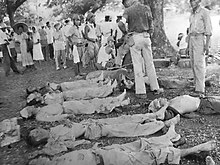1903 - Apolinario Mabini died of Cholera. Apolinario Mabini y Maranan was a Filipino revolutionary and lawyer who served as its first prime minister until May 1899. In Philippine history texts, he is often referred to as "the Sublime Paralytic", and as "the Brains of the Revolution." To his enemies and detractors, he is referred to as the "Dark Chamber of the President."
Mabini was most active in the Revolution in 1898, when he served as the chief adviser for General Emilio Aguinaldo. He became the president of the Cabinet and secretary of Foreign Affairs. He wrote most of the decrees of the revolutionary government and prepared a constitutional program wherein he proposed a Constitution for the Philippines.
Mabini found himself in the center of the most critical period in the new country's history, grappling with problems until then unimagined. Most notable of these were his negotiations with Americans, which began on March 6, 1899. The United States and the Philippine Republic were embroiled in extremely contentious and eventually violent confrontations. During the negotiations for peace, Americans proffered Mabini autonomy for Aguinaldo's new government, but the talks failed because Mabini’s conditions included a ceasefire, which was rejected. Mabini negotiated once again, seeking for an armistice instead, but the talks failed yet again. Eventually, feeling that the Americans were not negotiating 'bona fide,' he forswore the Americans and supported war. He resigned from government on May 7, 1899.
On December 10, 1899, during the Philippine-American war, he was captured by Americans at Cuyapo, Nueva Ecija, but was later set free. In 1901, he was exiled to Guam, along with scores of revolutionists the Americans referred to as "insurrectos" and who refused to swear fealty to imperialist America.
Mabini returned home to the Philippines in Feb. 1903 after agreeing to take the oath of allegiance to the United States on February 26, 1903 before the Collector of Customs. On the day he sailed, he issued this statement to the press:
To the chagrin of the American colonial officials, however, Mabini resumed his work of agitating for independence for the Philippines soon after he was back home from exile. On May 13, 1903 Mabini died of cholera in Manila, at the age of 39.[
Mabini was most active in the Revolution in 1898, when he served as the chief adviser for General Emilio Aguinaldo. He became the president of the Cabinet and secretary of Foreign Affairs. He wrote most of the decrees of the revolutionary government and prepared a constitutional program wherein he proposed a Constitution for the Philippines.
Mabini found himself in the center of the most critical period in the new country's history, grappling with problems until then unimagined. Most notable of these were his negotiations with Americans, which began on March 6, 1899. The United States and the Philippine Republic were embroiled in extremely contentious and eventually violent confrontations. During the negotiations for peace, Americans proffered Mabini autonomy for Aguinaldo's new government, but the talks failed because Mabini’s conditions included a ceasefire, which was rejected. Mabini negotiated once again, seeking for an armistice instead, but the talks failed yet again. Eventually, feeling that the Americans were not negotiating 'bona fide,' he forswore the Americans and supported war. He resigned from government on May 7, 1899.
On December 10, 1899, during the Philippine-American war, he was captured by Americans at Cuyapo, Nueva Ecija, but was later set free. In 1901, he was exiled to Guam, along with scores of revolutionists the Americans referred to as "insurrectos" and who refused to swear fealty to imperialist America.
Mabini returned home to the Philippines in Feb. 1903 after agreeing to take the oath of allegiance to the United States on February 26, 1903 before the Collector of Customs. On the day he sailed, he issued this statement to the press:
To the chagrin of the American colonial officials, however, Mabini resumed his work of agitating for independence for the Philippines soon after he was back home from exile. On May 13, 1903 Mabini died of cholera in Manila, at the age of 39.[







